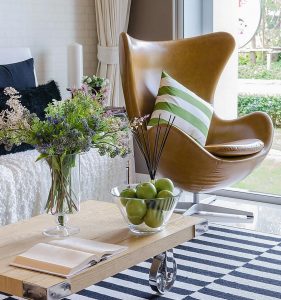If you find yourself downing coffee all day long due to sleepless nights, your bedroom might be the problem. Changing up your bedroom decor and environment can make a dramatic difference.
1. Choose colors that promote sleep. Bright yellow and red hues are not very relaxing and do not promote a restful environment. Aim to paint your sleep space with more muted, gentle earth tones, such as; warm beige, grays, soft greens, or ocean blues.
2. The ideal room for sleep is cool and dark. Most experts agree that the sweet spot for temperature is between 60 and 67 degrees Fahrenheit. According to a National Sleep Foundation poll, 73% of Americans say the darker the room the better. 65% of people use shades, curtains, or blinds to block unwanted light.
3. Banish electronics. Even though it can feel relaxing to kick back in bed and watch your favorite shows, research has shown that televisions actually steal sleep. Try to keep your TV viewing in the living room – NOT the bedroom – and turn it off 60 minutes before you want to sleep. Television right before bed is associated with several sleep problems and increased anxiety. Avoid other electronics that can potentially increase stress, worry, or strong emotions, which could include everything from social media to emails. Blue lights from electronics tell your biological clock that it’s time to wake up, which can throw off your sleep cycle.
4. Choose the right bedding. A comfortable mattress and pillows are essential for good sleep, but whether they’re soft or firm is up to you. The pillow you choose may depend on your preferred sleep position. If you’re a side sleeper (as most people are), your pillow should comfortably support your head and neck. People who sleep on their backs should consider a thinner pillow to limit stress on the neck. When it comes to sheets, you don’t need the highest thread count sheets on the market, but bedding fabrics should feel nice against your skin and not distract you from getting cozy. In addition, change your sheets often. In a recent sleep study, six out of 10 said they changed their sheets weekly or more often and roughly 3 out of 4 people said they got a more comfortable night’s sleep when their sheets had a fresh scent.
5. Declutter your bedroom. One of the things that will destroy a relaxing vibe in the bedroom is if there’s clutter everywhere. A study presented at the June 2015 SLEEP conference in Seattle suggests that those surrounded by clutter were more likely to have a sleep disorder. Consider investing in storage bins that slide under your bed or store items in nightstand drawers. What your eyes see when you walk into a room can influence whether or not you’ll have an easy time falling asleep. Less is best in a bedroom.
6. Sights and smells. Smell is nearly as important as visual elements in your bedroom. To help create a restful and relaxing oasis, have scented soy candles, diffusers, and essential oils in scents like chamomile or lavender. This helps promote a feeling of calmness. If you can, open a window to allow fresh air in for an even better result.
7. Make your bed every morning. It’s true, making your bed each day can help you sleep better at night. A National Sleep Foundation poll found that seven out of 10 people said they made their bed every day or almost every day. The bed-makers were 19% more likely to report getting a good night’s sleep on most days.
Cool, dark, relaxing, clean, cozy, and distraction-free are the key concepts to keep in mind when optimizing your bedroom for sleep.
SFY Resources
American Academy of Sleep Medicine
Photo by Houzz






